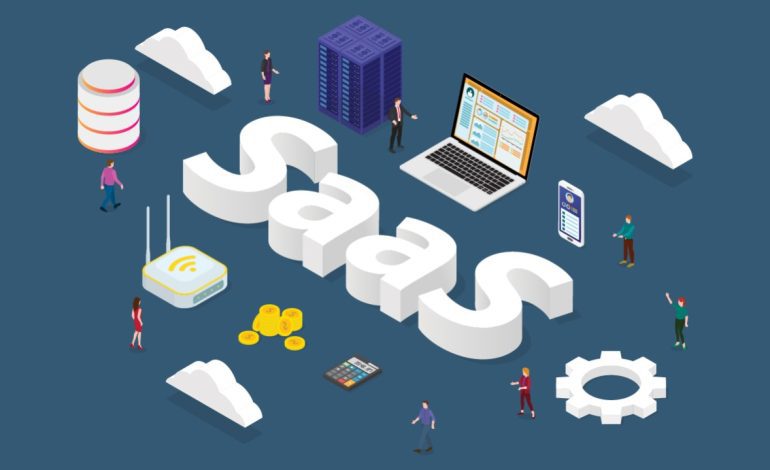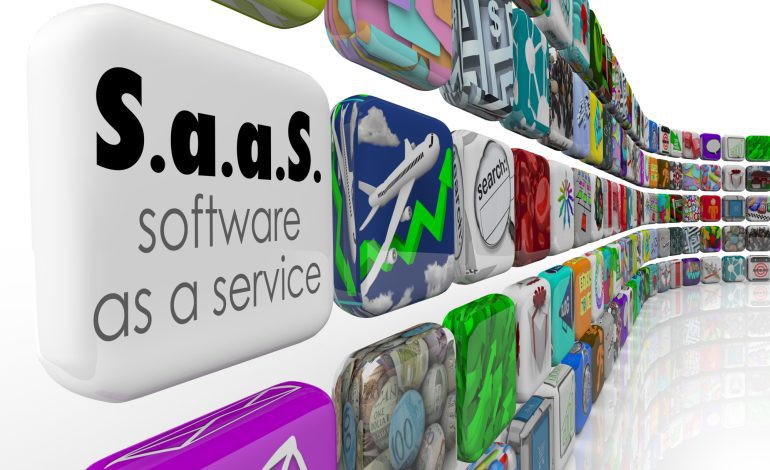In recent years, SaaS has become an increasingly popular software delivery model. Driven by the growing number of smart devices and the proliferation of public and private cloud services, the market for SaaS solutions is predicted to reach $307.3 billion by 2026.
Cost efficiency, flexible pricing model, as well as personalization and automation, is what make SaaS a model of choice when it comes to delivering software solutions. Software as a service has been an idea since the 1960s, but the first SaaS applications didn’t arrive until the turn of the century.
The term “software as a service” (also known as “SaaS”) refers to the practice of using the software as a service rather than by purchasing a license to use it. But the distinction between SaaS and conventional apps goes much beyond price. A SaaS application is one that you may access through a web browser or your mobile device without having to install it on your computer.
This also means that you can use it from anywhere in the world, as long as there’s an internet connection. From the development standpoint, it means that users can run an app even though the developers are continuously working on updates.
Cloud infrastructure is what makes SaaS apps so easily accessible. SaaS apps run in a cloud environment; the private or public cloud is also where a SaaS application is built and deployed.
SaaS app development is a trend that is expanding, and every day, thousands of SaaS mobile apps are launched on app stores. Continue reading to find out how to make a great SaaS app that will hold its own against the competition.
Step 1: Conduct market, client and competitor analysis
SaaS app development increasingly relies on new-gen tech, such as AI, Machine Learning, and immersive technologies. Start your product discovery phase with an in-depth analysis of the recent tech trends. If you want to build a vertical SaaS application, get to know the trends in your target market segment. Also, learn as much as you can about your target audience, their needs, and concerns as you refine your SaaS app idea.
Competitor analysis is an integral part of the ideation stage. Study the existing apps in your segment, define your core competitors and discover their weak points so that you can meet customers’ needs better.
Step 2: Choose your app monetization model
It is critical that you choose your SaaS app monetization model before you get fully immersed in the app development process. Your revenue model will ultimately dictate your app architecture and features, so you should have it carefully mapped out before you start building your app. Knowing your audience will help you understand how much your users can afford to spend for using your app.
There are several tried and true application models that work best for SaaS apps:
The Freemium model makes your app free to download, but the premium features are only available for a fee. Most cloud storage services, such as OneDrive or Dropbox, will offer a certain amount of space for free, and will charge fees for expanding your storage space.
Transaction fees and selling fees are a viable way for digital marketplaces to monetize their services. Whenever users make money using your app, they pay you a commission. You also get a small transaction fee from any money transfer. Freelancing marketplaces like Upwork are using this model to generate revenue.
In-app advertising is also an immensely widespread monetization model for SaaS apps. Users get free access to app services for viewing ads or commercial videos, while app owners get paid for ad clicks and views. A women health app, for example, may offer free insights and advice while advertising fertility clinics or private gynecologist services.
If you’re building a very niche-specific app, the Subscription model may work best. After a short trial period, your users will be offered to pay for a monthly, quarterly, or annual subscription. If the customers do find that your app delivers a distinct business value, this model will work best for generating revenue.
Needless to say, you can combine several app monetization models; on top of that, you can also benefit from analyzing and selling data that your app generates and collects.
Step 3: Plan for security and reliability in advance
As profitable as using SaaS for business may appear, the software as a service model is also associated with security risks and reliability issues. The main difference between SaaS and traditional apps is that SaaS apps run in the cloud, so you need to choose a reliable cloud vendor.
Read Also: How do I Choose a SaaS Vendor?
Reputable cloud service providers such as AWS, do their best to safeguard their clients’ data. They go the extra mile to ensure the integrity of data stored in their data centers and leverage the best security practices.
When it comes to using cloud services, multi-tenancy is also a frequent issue. Having multiple customers access an app places certain demands on the SaaS app architecture. In any case, be sure to select an optimal system architecture for your type of SaaS application and ensure that the data is encrypted and backed up.
Step 4: Plan for 3rd-party integration
SaaS software, especially intended for use in business environments, should integrate seamlessly with other enterprise tools and applications.
At the very least, it should contain open application programming interfaces (API’s) so that third-party developers could easily access the software code and program it to integrate with other applications. Pay specific attention when you are choosing an open API architecture to ensure reliability and security.
Step 5: Select a technology stack
To build a SaaS solution, you will have to select the optimal technologies for the application’s front end and backend, backend storage database, and application server.
- For the frontend, most SaaS applications use technologies like HTML and CSS, and Javascript frameworks such as Vue.js, React, and Angular.
- For the server-side of SaaS applications, software developers mostly use languages like Ruby, Python, JavaScript, PHP, and the corresponding frameworks.
- For backend storage, SaaS developers frequently use databases like MySQL, MongoDB or PostgreSQL.
- Finally, Nginx is often the best choice, when it comes to SaaS application servers.
The major aspect to take into account while choosing the tech stack is the scale of your project, the maturity of technology, and integrations with third-party systems.
Step 6: Build an MVP
MVP stands for a minimum viable product, i.e. a trial version of your SaaS app with basic features. The purpose of an MVP is to serve as a proof-of-concept and to give users and stakeholders ‘a taste’ of your product.
MVP is also built with a minimum budget, which enables you to test how the market accepts your product without getting into heavy expenses. On top of that, you can change your development approach or technology stack at this stage of your product development lifecycle.
Step 7: Start the development
During the development process, maintain constant communication with the development team to ensure that you share the same vision about the product’s features and requirements. Apply one of the Agile methodologies for continuous development, testing, and fast time-to-value.
It also makes sense to launch an early marketing campaign to build a community of loyal users anticipating the release.
Step 8. Production and maintenance
Only after the QA team has completed the beta-testing and checked the production server can an app be considered ready for publication and deployment. The user-acceptance testing, the process of testing your app with early adopters, will let you see how the market responds to your app.
When you create a SaaS application, you commit to its continuous maintenance and upgrade. The users that have your app installed on their devices should have seamless access to all application updates as well as 24/7 technical support.
Types of SaaS Applications
SaaS software serves a variety of purposes, yet, SaaS apps can be divided into a number of distinct subcategories. Below are the most common SaaS application examples, reflecting some of the prominent SaaS market trends.
CRM software
SaaS apps for customer relationship management help companies maintain and update their customer database, manage leads and marketing campaigns, forecast sales, provide reports and dashboards on sales activities, and automate marketing initiatives.
Salesforce and Hubspot are some of the most vivid examples of SaaS CRM apps.
Software for project management
SaaS software has already become an industry standard when it comes to project and workflow management. Cloud-based PM apps such as Asana, Jira, and Trello are accessible from everywhere and are great assets for an era of remote work.
eCommerce apps
As more and more brick-and-mortar stores move online, the demand for SaaS software for online store management also increases.
Shopify, for example, has all it takes for building and launching e-commerce websites, including product and supply chain management, and payment system integrations.
ERP software
Enterprise-grade resource planning software is also widely available in SaaS. Modern cloud-based ERP systems include complex data analytics suits and help enterprises process massive amounts of data.
SaaS solutions like Oracle ERP Cloud use ML and artificial intelligence to provide businesses with an end-to-end view of their operations.
Billing software
SaaS solutions for billing is another lucrative niche for SaaS application development. A cloud-based software like Tipalti can help businesses handle multiple online transactions, and assist digital marketplaces in conducting mass payments to suppliers and vendors.
SaaS-based collaboration tools
Remote work is here to stay whether we like it or not, and businesses on a global scale increasingly use SaaS tools for remote collaboration. Tools like Miro, for example, help remote and distributed teams build a smooth communication process, exchange files and documents, schedule and run video chats and much more.
During the COVID-19 crisis, the app Zoom has helped teams keep communication lines open despite the lockdown.
Marketing software
Software as a service became entrenched in the marketing niche, and we can see dozens of popular SaaS tools that help marketers analyze and improve their promotion tactics.
That’s exactly what Hootsuite does. It is a SaaS product for all sorts of content creators and marketers, which provides rich functionality for managing publications and communication on Facebook, Twitter, Instagram, YouTube, LinkedIn, and other popular platforms. An all-in-one dashboard that allows users to schedule posts, interact with their audience, discover preferences, and more.
Human resources management
Human resources departments are responsible for a range of staff-related tasks. Specific SaaS applications simplify gathering information about potential employees, managing job offerings, tracking and evaluating staff performance and engagement, as well as compensation procedures.
Among SaaS examples for HR management, BambooHR stands out as an all-in-one tool that covers hiring, onboarding, compensation, and company culture-related assistance.
Vertical SaaS apps
Vertical SaaS apps are niche-specific and help market players in a particular industry or segment streamline and optimize their processes and improve their efficiency. Hotschedules, for example, is a solution for restaurant management offering restaurants a comprehensive toolset for workflow and labor management, staff training, inventory management, and planning.
Another example is Procore – a project management tool for the construction industry loaded with features for effective communication, collaboration, sharing plans and project specs, and tackling any unexpected challenges that the construction work might entail.
Finally
With lower subscription fees, enhanced accessibility and availability, 24/7 tech support, and on-demand scaling, SaaS apps have a number of distinct advantages over traditional software. Yet, how to develop a SaaS application is never an easy question: apart from choosing a reliable cloud vendor and deciding on an optimal app architecture and tech stack, the cost and availability of tech talent pose a real challenge.
Building a team of qualified experts with solid SaaS development experience may take months, potentially risking the loss of your competitive edge. With this regard, partnering with a pre-vetted software development provider with proven expertise in building SaaS apps is a viable alternative to setting up an in-house team for SaaS development.


